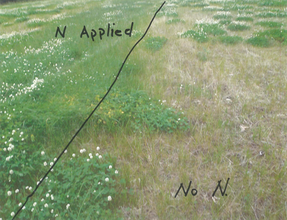CONSERVATION CORNER
A weekly blog for all things conservation
 By: Kevin Brown, Ag Team Leader I was struggling for a good topic this week when I guy walked in and started asking me about reseeding a field. How to do it, what he should use, etc. I think there are still enough people out there making hay on a lot of Bradford County fields so I will hit that topic this week. First off, we need rain! For non-farmers, how could you ask for a better year? Warm, dry, just beautiful weather. For farmers and gardeners, not so much. Anyway, hay production. First, we need rain. After that, I will hit some other highlights that we can control. Your soil is a “bank account”. It has “funds” in it. As you harvest each cutting, you remove “funds” from that account. You continue to do that and guess what is left 5 years down the road? Nothing. The hay runs out. Weeds start to grow. You get one cutting instead of 3 or 4, and it gets progressively worse. If we want to remedy that situation, there are several options to think about. The first one that comes to mind is that we need to reseed. That means big equipment, lots of time, equipment that most people don’t have anymore, etc. Plus, if you “bank account” is empty, the seeding might look good for 2-3 years as the legumes can produce their own nitrogen and even produce enough to help with the grasses, but eventually it runs out and you have exactly what you have now. And you spent a ton of time and money to do it.
The next option is just no-tilling or frost seeding some legumes into the stand. Again, the legume will produce nitrogen for themselves, and the other plants. This option takes very minimal equipment. However, you still only get the short-lived kick from them. The “bank account” is still empty. It will run out fast. Finally, the next option is to replace the “funds” in the “bank account”. I know, it’s expensive. I got it, but there is no other way. Nothing long term. You are removing nutrients. You need to replace them or suffer the consequences. I have seen dairy/beef farms go out of business and 5 years later their hayfields look like crap. They wonder, “what happened?”. What happened is that the thing you used to think was a waste product, manure, was fertilizing your fields. Now that you don’t have that, you can’t maintain your fields. Now, what to put on. Well, in a perfect world you would take a soil sample and put everything on that it says it requires. Right now that may amount to $500/acre or more. Yea, $500 per ACRE. Yikes. So, figure out what you have for a budget and then start with what is needed most and work your way down the totem pole. Others would tell you that lime is most important. We have said that for years. I say hogwash. LOL. Nitrogen is what is needed. Period. And until you have enough of that, nothing else matters much. We are talking grasses here. I can show research where 250 pounds of nitrogen will get you 2 plus ton of hay. Now this is a bad year to do math on this because urea is $1000/ton, or at least it was. Even at those numbers (for easy math, I will use $920), 200# of N will cost you $200. $200 gets you 2 ton more yield. That is $100/ton for hay. You won’t be able to touch hay for $200 per ton by the time the year is out, let alone $100. You are producing hay at half the cost. If urea was back at it’s $450/ton, then you would get a ton of hay for $50. You can’t buy it for that, and you will sell it for a lot more. After that, what is your pH? Add lime. What is your P and K? Add those two nutrients. See where I get $500/acre from? It costs a lot of money. That is why people don’t do it. So, get one or two ton per acre for “free”, or fertilizer it and get 4-5 ton. It is still profitable to do so. And oh yea, the weeds will disappear too. Nothing can compete with good grass hay IF you fertilize it correctly. Weeds come in because it lacks something. There are other sources of nutrients. I can hit that next week. The Bradford County Conservation District is committed to helping people manage resources wisely. You can visit the Bradford County Conservation District at 200 Lake Rd in Wysox across from the Wysox Fire Hall. Contact us at (570) 485-3144 or visit our web page at www.bccdpa.com.
0 Comments
Leave a Reply. |
AuthorsVarious staff at the Bradford County Conservation District Archives
July 2024
Categories
All
|
|
Bradford County Conservation District
Stoll Natural Resource Center 200 Lake Road, Suite E | Towanda PA 18848 Phone: (570)-485-3144 |
